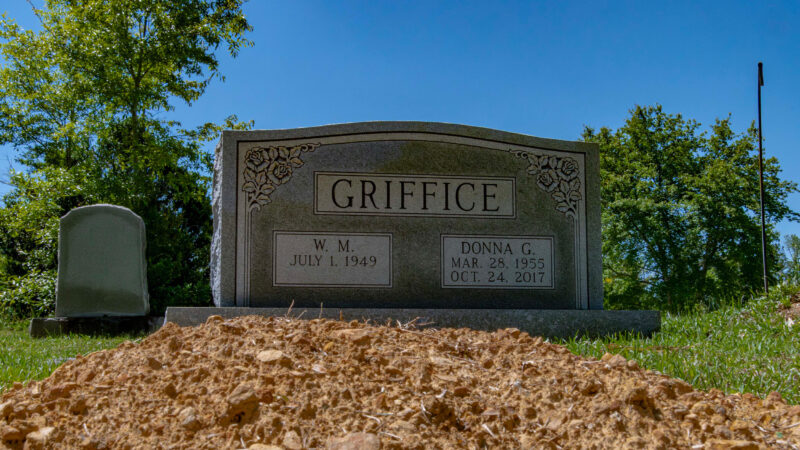Recycled/Remade: Folk Art at the BMA
I certainly don’t think the south has a monopoly on folk art, but there is a large, large number of people working today and whether that’s from the fact that we still have some more isolated environments whether there is that religious vein here that is a strong, strong vein whether there’s a greater tolerance for people who are a little eccentric. And we have that strong streak in literature, perhaps we applaud that in visual arts as well I don’t know. But Alabama is the home of so many of these artists. I mean we’re standing in front of a Bill Traylor. Certainly one of the most if not the most important of all the self-taught artists. Most heralded figures.
Traylor was born a slave in 1854 on a Benton, Alabama plantation. He came to art late in life and had a very short career before his death in 1949.
Moved to Montgomery in the late 30s and lived in the back of a funeral parlor for most of his time there and began just drawing on scraps of cardboard, abandoned paper, boxes, whatever he could find. Using pencil, colored pencil, charcoal pencil, in general. Straight edge to help him with some of his figures. He did some of the most creative, distinctive drawings ever of any artist, anytime, anyplace.
Traylor’s piece in this exhibit features a man who’s missing half of his leg. Traylor himself lost a leg to diabetes. It’s a common thread. Many folk artists, including Alabama’s Mose Tolliver, found their creative voices after injuries, illness, or life challenging events.
He grew up in the Montgomery area and he was working for a furniture factory, I think in the early 60s, when a load of marble fell on his feet and crushed his feet. And he’s been confined to a walker or crutches since then. His former employer encouraged him to start painting and even take some painting classes. Toliver decided he didn’t need the classes, but he liked the idea of painting. And he started painting. His early works were birds and flowers.”
“He’s also famous for the woman that you see here in the center of the panel. Woman on a Scooter. These pretty phallic-looking drawings of women with their legs up over their heads that he would always laugh about, call his Moose Women, or as I said, Woman on a Scooter. He’d kind of giggle about them. Always paints his own borders, like a frame, and usually adheres a little aluminum ring soda can, beer can top as hangers as well.
Mose T is known for his use of color but what might surprise some museum goers is that the paint is house paint. Tolliver uses whatever’s on hand as does Birmingham native Lonnie Holley — part of a younger generation of more urban folk artists.
People initially met Lonnie through his sandstone. And he began carving. He carved a tombstone for his sister’s child who had died and found that it was a medium that allowed him to express himself in a variety of ways. And then he went into painting. And you see this painting we have over here of a real Christ-like figure. It’s calledFading Like the Seasons of Time.
An untrained eye might mistake the painting for the scribbling of a preschooler, but Gail Trechsel says a closer look reveals there’s a lot more going on in this piece.
There are some amazing drawings by children which museums are interested in. But usually I would say to answer that the topics that children are choosing for their artwork are usually not what adults are choosing for their artwork. And here we see a face that is pained. That is, I think has this tortured eye and mouth and there’s a sadness a thoughtfulness about oneself and the passage of time that I don’t think we’d find in a children’s drawing. And I think that sometimes folk artists are called child-like, but they’re not making art from child concerns or child topics.
Today’s folk art is not just the idyllic, rural farm scenes of Grandma Moses. It takes on tough issues race relations, poverty, societal ills. And society doesn’t always approve as Lonnie Holley discovered with his sculpture garden made of found objects.
He had about an acre near the airport in Birmingham and it was an incredible environment. People came from all over the world to see it. The airport wanted to expand. There were many people who tried to save that environment and there was another area that was found that was nearby that we hoped we could help Lonnie move to, but there was so much pressure from the neighborhood. They didn’t want this person, who’s either seen as crazy or eccentric or messy or this or that or whatever it might be. This isn’t easy for people and you’re right, public art in general can be hard. If it doesn’t make you stop and think and is arresting, then why have it?
Holley eventually moved his garden to a larger plot in Harpersville, Alabama. Over in Summerville, Georgia, there’s a famous folk art garden built by artist Howard Finster, perhaps the best known artist in the Birmingham show. Finster, who was born in Alabama, built the world’s largest folk art church. His painting in this exhibit is smaller in scale, but Gail Trechsel says very grand in vision.
“This painting is on a metal table top. Two presidents that he admired greatly. Franklin Roosevelt and Woodrow Wilson. And they were presidents during the first and second world wars. And he saw them as men of visions. And you’ll see their eyes eyes that have these concentric circles that are almost glowing out of the paintings to show that these two were men of vision. But in the center, between these two paintings, is this message. Who will be president in worlds war three? And when will it be, in the year of 2003? Didn’t hit me until I hung this, and I was hanging it during the war with Iraq. That the image that he has painted is very close to Jimmy Carter, who had been elected just six months before or so when this painting was done. His fellow Georgian. And here’s Carter, who’s won the noble prize, here we are. You know, I thought, well maybe he really was a man of vision. Maybe he really did know something.
Some considered Finster a visionary. Critics labeled him mercenary for what they saw as an insatiable commercial streak in this artist-preacher. Finster produced more than 20-thousand paintings in his lifetime. Gail Trechsel disputes the claim that Finster and other folk artists have sold out, though she admits that commercial popularity has taken its toll.
In the mid 80s, early 90s, there was just this frenzy of buying and I think a lot of artists were pushed unnecessarily. Their work did suffer. They became repetitive. A collector or a dealer or a curator or whomever would come in and say, I want one just like the one you know. And making demands of people that were really pretty intolerable and unfair. On the other hand, I do think a lot of these artists have benefited financially and have had a much nicer standard of living because of their commercial success.
The exhibit of folk art, Recycled/Remade, runs through October 5th at the Birmingham Museum of Art.
Alabama coal company sued for a home explosion is delinquent on dozens of penalties
Crimson Oak Grove Resources has been cited for 204 safety violations since the March 8 blast, many involving “significant and substantial” safety violations.
The United Auto Workers faces a key test in the South with upcoming vote at Alabama Mercedes plant
The United Auto Workers is aiming for a key victory at Mercedes-Benz in Alabama. More than 5,000 workers at the facility in Vance and nearby battery plant will vote this week on whether to join the UAW.
Gambling, ethics bills fall short as legislative session ends
Alabama lawmakers closed the books on this year’s regular legislative session Thursday. While Republican leaders passed many of their priority bills, perhaps the most talked about issue – gambling – died.
A look at what passed and failed in the 2024 legislative session
Alabama lawmakers have ended a 2024 legislative session that saw the Republican majority win approval for a number of their top priorities.
Q&A: Bobby Carter on leading Tiny Desk, his time at Jackson State, early career advice
Carter, a Jackson State alumnus, took over as the new series host and producer for NPR’s “Tiny Desk Concerts” series in April.
Alabama to begin working with a consulting company that’s under criminal investigation
McKinsey & Company, an international consulting business, will help the state of Alabama develop a new strategic economic growth plan. The company is undertaking that project, while also dealing with a probe into whether it engaged in a criminal conspiracy.







